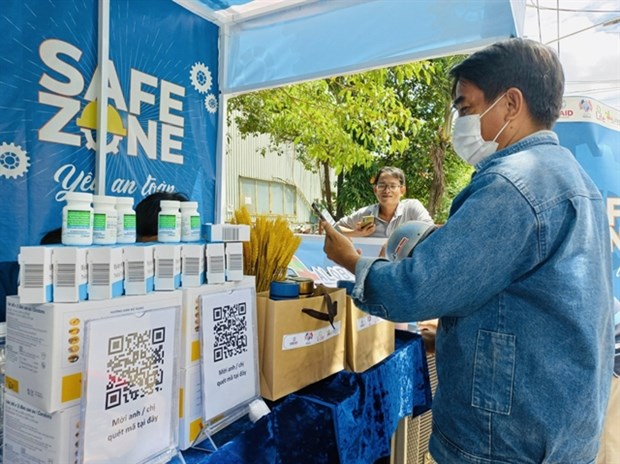 A HIV prevention intervention model for factory workers initiated by LIFE, is being piloted in HCM City and Dong Nai province. (Photo courtesy of LIFE)
A HIV prevention intervention model for factory workers initiated by LIFE, is being piloted in HCM City and Dong Nai province. (Photo courtesy of LIFE)HCM City
(VNS/VNA) – More than 15,000 factory workers at high risk of HIV infection have
access to HIV prevention and treatment services through an HIV prevention
intervention model called SAFE-ZONE, according to the Vietnam Administration
for HIV/AIDS Control (VAAC).
Speaking at a recent
workshop held in Ho Chi Minh City, Nguyen Thi Minh Tam, head of VAAC’s Department of
HIV/AIDS Prevention and Control, said the model is being piloted at four
factories in Ho Chi Minh City and Dong Nai province and has seen positive
results.
It has provided HIV
testing and counseling services for 350 workers, connected more than 60 cases
with pre-exposure prophylaxis (PrEP) drugs, and transferred 11 cases to ARV to
receive anti-retroviral () treatment at health facilities.
“The results showed the
effectiveness of this model. The model’s implementation steps are very clear
and easy to measure and apply,” she said.
So any locality that has
many industrial parks and factories with a network of community-based
organisations providing available services can consider conducting
this model, she said.
The model is an
initiative of the Centre for Promotion of Quality of Life (LIFE) and
community-based organisations (CBOs), contributing to helping the healthcare
sector to achieve the national goal of ending the HIV/AIDS epidemic by 2030.
Nguyen Nguyen Nhu Trang,
director of LIFE, said this model was built in the context of increasing the
number of HIV infection cases detected among .
The model updates and
provides the factory workers information and knowledge about sexual health, HIV
prevention, and sexually transmitted diseases (STDs). It also helps connect
them to private HIV testing and treatment services provided by CBOs, she said.
The following is the
model’s five-step implementation:
Step 1: Contact the
factory
Actively contact to ask
for a meeting with representatives of the factory in the area identified by
health authorities with an increasing number of HIV infections.
The purpose of the
meeting is to present the HIV situation in the locality, identify needs, agree
on a cooperation method and develop a communication plan on HIV prevention and
treatment services for factory workers.
Step 2: Survey workers
in the factory
Conduct a survey on
knowledge, attitude and practice (KAP) about HIV and other STDs among factory
workers to design appropriate communication programmes.
Step 3: ‘Passive’
Communication
Implement passive
communication programmes such as putting up posters, providing leaflets with QR
codes, posting articles on the factory’s information page and Zalo group, and
make media products that attract workers’ attention on YouTube and Tiktok.
Step 4: Active
communication
Coordinate with the
factory to implement on-site communication programmes to attract the direct
participation of workers such as events, seminars and creative worker contests.
These activities are carried out in a dynamic style, combined with distribution
of items such as condoms, lube and self-testing products.
Introduce to the workers
“CBO Around U” page to connect with CBOs, and the D-Health app to proactively
contact the nearest CBO.
Step 5: Consult, test
and transfer
CBOs or the community
one-stop-shop health service (DOME) stores will actively contact or receive
information directly from customers through the website, phone or via the
D-Health app to provide screening tests and consulting, and connect the
customers to appropriate health facilities.
Since 2008, LIFE has
conducted a programme to improve the quality of life for factory workers in 34
provinces and cities nationwide.
The programme has
supported 300,000 workers in 150 factories with issues relating to protecting
legitimate rights, providing workplace safety and better health care, gender
equality, improving skills for financial management, and personal development./.
Source: VietnamPlus
